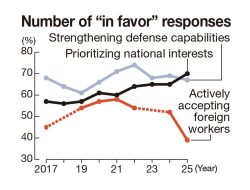
Chi. Chikyu no Undo ni tsuite (About the movement of the earth)
by By Uoto(Shogakukan)

10:45 JST, February 19, 2021
While it may be common knowledge taken for granted, even kids know the Earth revolves around the sun.
“Hey, you know what? People in olden times used to believe the Earth was at the center of the universe. They thought the sun and planets revolved around the Earth.”
“Ha ha, that’s funny!”
But if we think about it, the amount of time that humans believed in the Ptolemaic theory was much longer than the time when they didn’t. And nothing about that was inconvenient as they went about their daily lives. Even now, there is little inconvenience either way. At least, I can’t think of any, right off the top of my head.
Despite that, there were people who came to think that the Earth was moving. They insisted on it, and like Galileo, some scholars were tried in the Inquisition. This baffles me. What kind of passion drove these people to that extreme?
The story of this manga unfolds in what appears to be the kingdom of Poland in the first half of the 15th century. The protagonist, orphan boy Rafau, overcomes adversity with his intellect and resourcefulness. He is accepted to a university at the age of 12 and has a rosy future ahead of him. One day, he meets a heretic scholar named Hubert who asks him about the shape and design of the universe. Rafau responds by drawing an illustration of a Ptolemaic system with the Earth placed in the center, a common belief at that time. However, Rafau himself has previously had an inkling that the planetary motions in the diagram are complex and not very attractive.
Hubert teaches Rafau that the universe would become far more simple, orderly and beautiful in a diagram that theorizes the Earth is moving. To advocate heliocentrism, or the fact that the Earth revolves around the sun, was considered heresy, a rebellious belief against God.
Hubert dies, burned at the stake. However, the beauty of the universe that Hubert preached now has a tight grip on Rafau’s heart and won’t let go.
Nicolaus Copernicus first made his heliocentric theory public in 1543 when he published “On the Revolutions of Heavenly Spheres.” The story of this manga, which has only just begun, is apparently about his nameless forerunners who realized much earlier than Copernicus that the Earth moves. A drama about how they risked their lives to hand down knowledge is expected to unfold.
Apparently, heliocentrism was accepted as scientifically proven from the 18th century onward, so in the days of Copernicus and Galileo, heliocentrism was still in the realm of unthinkable and outrageous hypotheses. This is probably why this manga doesn’t have a simple structure in which scientific truth is justice and religion that oppresses it is evil.
Try substituting heliocentrism with something in the modern world with any contemporary issue that is frustrating because it seems somehow strange yet difficult to explain. If you felt that a solution was beautiful and correct, even if it isn’t common sense or goes against the norm, would you have the strength and commitment to pursue it, even if the whole world was against you?
I believe this manga provides a way to approach that question.
Honestly speaking, the drawings by manga author, Uoto, are not impressive. However, his peculiarly subdued touch matches the theme. If he were a better artist, who could draw more graphically realistic art, I don’t think this manga would have been that attractive. Perhaps, even such a realization may be called, in a way, Copernican.
"Culture" POPULAR ARTICLE
-

Dior, Gucci Adapt Kyoto’s Traditional Textiles for Modern Tastes
-

Event Held at Kyoto State Guest House to Showcase Beauty of Traditional Japan, Includes Crafts, Cuisine, Performances
-

Van Cleef & Arpels Dazzles with Art Deco Artisanry at Tokyo Exhibit
-

Ainu Thanksgiving Festival to Be Held in Tokyo with Performances from Ainu, Other Indigenous Groups
-

Disney’s ‘Twisted-Wonderland’ Animated Series Puts Villains in Spotlight: New Show Features School Inspired by Classic Disney Films
JN ACCESS RANKING
-

Govt Plans to Urge Municipalities to Help Residents Cope with Rising Prices
-

Japan Resumes Scallop Exports to China
-

Japan Prime Minister Takaichi Vows to Have Country Exit Deflation, Closely Monitor Economic Indicators
-

Japan to Charge Foreigners More for Residence Permits, Looking to Align with Western Countries
-

JR East Suica’s Penguin to Retire at End of FY2026; Baton to be Passed to New Character




◎上海の日本アニメイベント_20251129YGTGS000921_C-250x168.jpg)

















